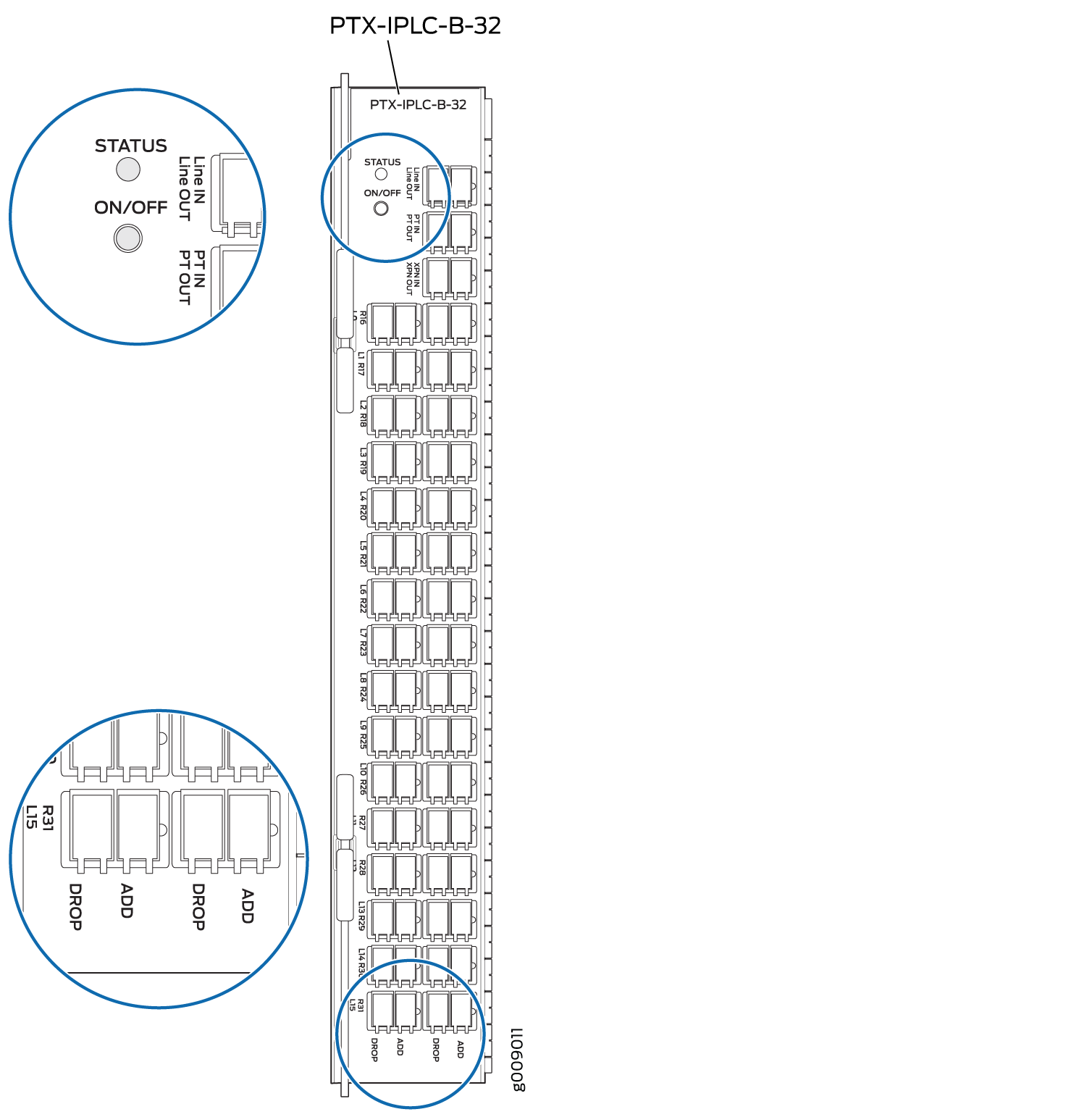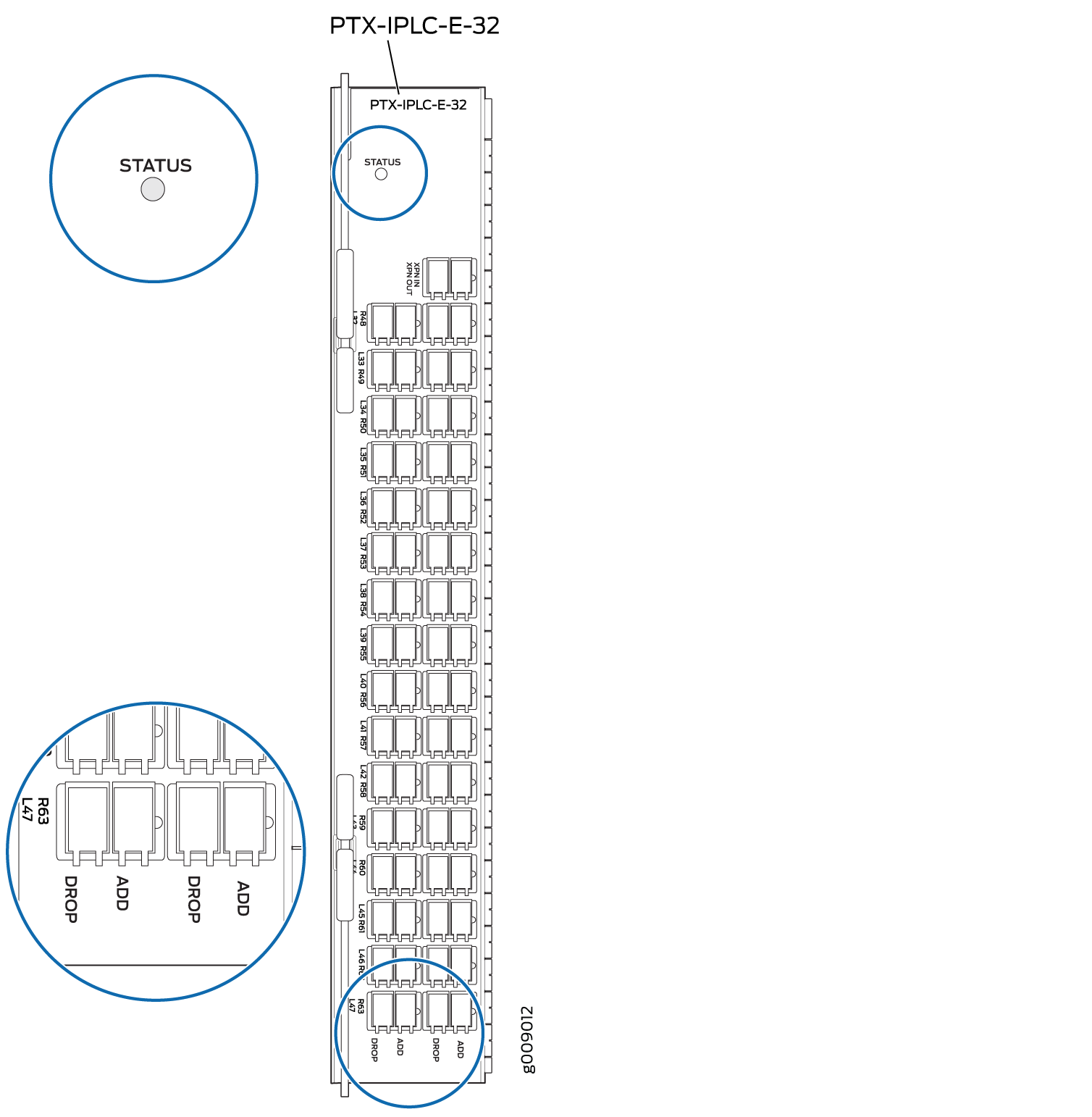ON THIS PAGE
PTX3000 IPLC Description
The integrated photonic line card (IPLC) base
module (PTX-IPLC-B-32) is an integrated optical card that provides
the combined functionalities of optical multiplexing and demultiplexing,
optical amplification, optical equalization, and optical channel monitoring.
The IPLC multiplexes and enables amplification of up to 32 individual
wavelengths for transmission over single-mode optical fiber (through
the add and drop ports on the front panel). The add and drop ports
on the front panel of the IPLC connect to compatible dense wavelength-division
multiplexing (DWDM) PICs or MICs. The wavelengths from the add and
drop ports on the IPLC are amplified, monitored, and controlled and
then transmitted toward toward the line direction (through the Line IN and Line OUT ports on the
front panel). In the reverse direction the received signals from
the line are amplified to enable long distance transmission and then
demultiplexed into individual wavelengths and sent to the respective
add and drop ports on the front panel.
The IPLC expansion module (PTX-IPLC-E-32) is an optical multiplexing and demultiplexing card that interfaces with the IPLC base module to increase the add/drop capacity of the system up to 64 channels.
In a PTX3000 chassis, you can install an IPLC in any of the
FPC or PIC slots. The IPLCs install vertically in the front of the
PTX3000. Up to 16 IPLCs or 8 base modules and 8 expansion modules
are supported in a PTX3000 chassis. Each expansion module must be
connected to a base module. The IPLC connects directly to the integrated
DWDM PICs/MICs (for example; the P1-PTX-2-100G-WDM or PTX-5-100G-WDM)
in the same chassis, or an external chassis through the IPLC front
panel add and drop ports. Also, the IPLC can connect to another IPLC
in the same chassis through the bi-directional express ports (XPN IN and XPN OUT) to enable an
optical bypass function.
The IPLC can also connect to an optical inline amplifier (ILA) in the network to enable transmission across longer spans. See the Optical Inline Amplifier Hardware Guide for more details about the optical ILA.
Figure 1 shows a point-to-point configuration for an IPLC.

In this example, the IPLC in the PTX3000 chassis is connected
to compatible PICs in the same chassis through the add and drop ports.
The wavelengths from the add and drop ports on the IPLC are multiplexed
and then amplified, monitored, and transmitted in a single fiber toward
the line (through the Line OUT port on the IPLC)
and connected to the IPLC (through the Line IN port) in the remote PTX3000 chassis through the optical ILA . The
IPLC connects to the optical ILA through the Line IN and Line OUT ports. The optical ILAs provide
periodic amplification of the signal to enable long distance transmission
and are typically placed between 50 miles (80 km) and 62 miles (100
km) apart . The signals received by the IPLC in the remote chassis,
are demultiplexed into individual wavelengths and sent to the respective
add and drop ports (which are connected to the compatible PICs) in
that PTX3000 chassis.
For information on configuring the IPLCs, see the Integrated Photonic Line Card (IPLC) Feature Guide.
IPLC Base Module
The IPLC base module provides the following optical functions:
Multiplexing and demultiplexing of up to 32 channels spaced at 100 GHz.
Amplification of the aggregate multiplexed wavelengths to enable long distance transmission.
Per channel power monitoring and control through the use of an on-board optical channel monitor (OCM) and wavelength selective switch (WSS).
Bypass of optical channels between pairs of IPLCs for low-cost optical networking. Two IPLC base modules installed in the same chassis can form an optical bypass. In addition, adding an expansion module (connected to an IPLC base module) can expand the number of channels supported beyond the 32 channels, up to 64 channels.
Support for the optical supervisory channel (OSC) is transmitted through an 0C-3 1510nm signal that enables the IPLC to communicate with the remote IPLC or communicate and manage the optical ILA.
IPLC Base Module Components

Each IPLC base module weighs 6.3 lb. (2.85 kg). See Figure 2. The add and drop ports are numbered 0 to 31 and the port numbers are denoted by R and L. For example, as shown in the lower magnified view in Figure 2, L15 refers to the add and drop port on the left side and R31 refers to the add and drop port on the right side on the front panel.
The IPLC base module consists of these components:
STATUSLED that displays the status of the IPLC.ON/OFFbutton that resets the IPLC.Line INandLine OUTports—An input and an output port to connect to another optical network element. You can use these ports to connect to another IPLC or to the optical ILA.PT INandPT OUTports—An input and an output port to connect to an another IPLC base module. Two IPLCs can be installed in the same chassis to form an optical express-in bypass.XPN IN(expansion-in) andXPN OUT(expansion-out) ports—An input and an output port to connect to an IPLC expansion module.ADDandDROPports—A total of 32 pairs of ports (32 add ports and 32 drop ports) for 32 DWDM channels.
All the ports on the IPLC use fiber-optic cables with LC connectors.
Table 1 provides the supported wavelength allocation on the IPLC ports.
Table 1: Supported Wavelength Allocation for the IPLC Base Module (PTX-IPLC-B-32)
Frequency (THz) | Central Wavelength (nm) | Port number on the IPLC Base module |
192.05 | 1561.01 | 0 |
192.15 | 1560.20 | 1 |
192.25 | 1559.39 | 2 |
192.35 | 1558.58 | 3 |
192.45 | 1557.77 | 4 |
192.55 | 1556.96 | 5 |
192.65 | 1556.15 | 6 |
192.75 | 1555.34 | 7 |
192.85 | 1554.54 | 8 |
192.95 | 1553.73 | 9 |
193.05 | 1552.93 | 10 |
193.15 | 1552.12 | 11 |
193.25 | 1551.32 | 12 |
193.35 | 1550.52 | 13 |
193.45 | 1549.72 | 14 |
193.55 | 1548.91 | 15 |
193.65 | 1548.11 | 16 |
193.75 | 1547.32 | 17 |
193.85 | 1546.52 | 18 |
193.95 | 1545.72 | 19 |
194.05 | 1544.92 | 20 |
194.15 | 1544.13 | 21 |
194.25 | 1543.33 | 22 |
194.35 | 1542.54 | 23 |
194.45 | 1541.75 | 24 |
194.55 | 1540.95 | 25 |
194.65 | 1540.16 | 26 |
194.75 | 1539.37 | 27 |
194.85 | 1538.58 | 28 |
194.95 | 1537.79 | 29 |
195.05 | 1537.00 | 30 |
195.15 | 1536.22 | 31 |
IPLC Expansion Module
The IPLC expansion module connects to the IPLC base module through
the XPN IN and XPN OUT ports.
It provides the following optical functions:
Increases the total optical DWDM channel capacity by 32 ports. It does not interface directly with the network.
Provides multiplexing and demultiplexing of up to 32 channels spaced at 100 GHz.
IPLC Components

Each IPLC expansion module weighs 3.3 lb. (1.49 kg). See Figure 3. The add and drop ports are numbered 32 to 64 and the port numbers are denoted by R and L. For example, as shown in the lower magnified view in Figure 3, L47 refers to the add and drop port on the left side and R63 refers to the add and drop port on the right side on the front panel. The IPLC expansion module consists of these components:
STATUS LED that displays the status of the IPLC.
XPN IN(expansion-in) andXPN OUT(expansion-out) ports—A pair of input and output ports to connect to the IPLC base module.ADDandDROPports—A total of 32 pairs of ports (32 add ports and 32 drop ports) for 32 DWDM channels.
All the ports on the IPLC use fiber-optic cables with LC connectors.
Table 2 provides the supported wavelength allocation on the ports.
Table 2: Supported Wavelength Allocation for the IPLC Expansion Module (PTX-IPLC-E-32)
Frequency (THz) | Central Wavelength (nm) | Port number on the IPLC Expansion Module |
|---|---|---|
192.10 | 1560.61 | 32 |
192.20 | 1559.79 | 33 |
192.30 | 1558.98 | 34 |
192.40 | 1558.17 | 35 |
192.50 | 1557.36 | 36 |
192.60 | 1556.55 | 37 |
192.70 | 1555.75 | 38 |
192.80 | 1554.94 | 39 |
192.90 | 1554.13 | 40 |
193.00 | 1553.33 | 41 |
193.10 | 1552.52 | 42 |
193.20 | 1551.72 | 43 |
193.30 | 1550.92 | 44 |
193.40 | 1550.12 | 45 |
193.50 | 1549.32 | 46 |
193.60 | 1548.51 | 47 |
193.70 | 1547.72 | 48 |
193.80 | 1546.92 | 49 |
193.90 | 1546.12 | 50 |
194.00 | 1545.32 | 51 |
194.10 | 1544.53 | 52 |
194.20 | 1543.73 | 53 |
194.30 | 1542.94 | 54 |
194.40 | 1542.14 | 55 |
194.50 | 1541.35 | 56 |
194.60 | 1540.56 | 57 |
194.70 | 1539.77 | 58 |
194.80 | 1538.98 | 59 |
194.90 | 1538.19 | 60 |
195.00 | 1537.40 | 61 |
195.10 | 1536.61 | 62 |
195.20 | 1535.82 | 63 |
